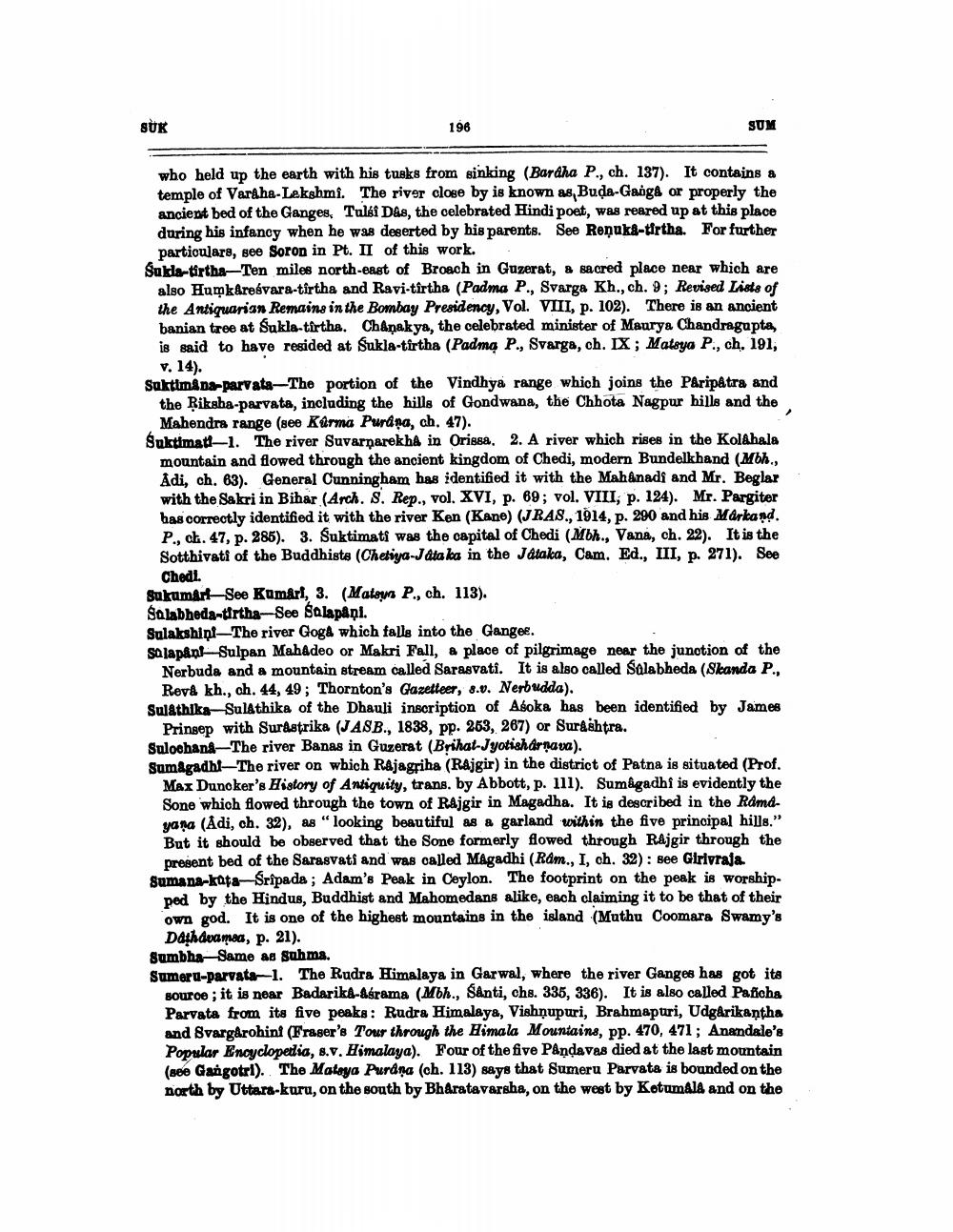________________
SUK
196
SUM
who held up the earth with his tusks from sinking (Bardha P., ch. 137). It contains a temple of Varaha-Lakshmi. The river close by is known as, Buda-Ganga or properly the ancient bed of the Ganges, Tulsi Das, the celebrated Hindi poet, was reared up at this place during his infancy when he was deserted by his parents. See Reņuka-tirtha. For further particulars, see Soron in Pt. II of this work.
Sukla-tirtha-Ten miles north-east of Broach in Guzerat, a sacred place near which are also Humkaresvara-tirtha and Ravi-tirtha (Padma P., Svarga Kh., ch. 9; Revised Lists of the Antiquarian Remains in the Bombay Presidency, Vol. VIII, p. 102). There is an ancient banian tree at Sukla-tirtha. Chanakya, the celebrated minister of Maurya Chandragupta, is said to have resided at Sukla-tirtha (Padma P., Svarga, ch. IX; Matsya P., ch. 191, v. 14).
Suktimana-parvata-The portion of the Vindhya range which joins the Pâripâtra and the Riksha-parvata, including the hills of Gondwana, the Chhota Nagpur hills and the Mahendra range (see Karma Purana, ch. 47).
Suktimati-1. The river Suvarnarekha in Orissa, 2. A river which rises in the Kolahala mountain and flowed through the ancient kingdom of Chedi, modern Bundelkhand (Mbh., Adi, ch. 63). General Cunningham has identified it with the Mahanadi and Mr. Beglar with the Sakri in Bihar (Arch. S. Rep., vol. XVI, p. 69; vol. VIII, p. 124). Mr. Pargiter has correctly identified it with the river Ken (Kane) (JRAS., 1914, p. 290 and his Markand. P., ch. 47, p. 285). 3. Suktimati was the capital of Chedi (Mbh., Vana, ch. 22). It is the Sotthivati of the Buddhists (Chetiya-Jataka in the Játaka, Cam. Ed., III, p. 271). See Chedi.
Sukumari-See Kumari, 3. (Mateyn P., ch. 113).
Salabheda-tirtha-See Salapāņi.
Sulakshini-The river Goga which falls into the Ganges.
Salapan Sulpan Mahadeo or Makri Fall, a place of pilgrimage near the junction of the Nerbuda and a mountain stream called Sarasvati. It is also called Sulabheda (Skanda P., Revà kh., ch. 44, 49; Thornton's Gazetteer, 8.v. Nerbudda).
Sulathika-Sulathika of the Dhauli inscription of Asoka has been identified by James
Prinsep with Surastrika (JASB., 1838, pp. 253, 267) or Surashtra. Sulochana-The river Banas in Guzerat (Brihat-Jyotisharṇava).
Sumagadhi-The river on which Rajagriha (Rajgir) in the district of Patna is situated (Prof. Max Duncker's History of Antiquity, trans. by Abbott, p. 111). Sumâgadhi is evidently the Sone which flowed through the town of Rajgir in Magadha. It is described in the Ramayana (Adi, ch. 32), as "looking beautiful as a garland within the five principal hills." But it should be observed that the Sone formerly flowed through Rajgir through the present bed of the Sarasvati and was called Magadhi (Ram., I, ch. 32): see Girivraja. Sumana-kata-Sripada; Adam's Peak in Ceylon. The footprint on the peak is worshipped by the Hindus, Buddhist and Mahomedans alike, each claiming it to be that of their own god. It is one of the highest mountains in the island (Muthu Coomara Swamy's Dahdan, p. 21). Sumbha-Same as Suhma.
Sumeru-parvata-1. The Rudra Himalaya in Garwal, where the river Ganges has got its source; it is near Badarika-Asrama (Mbh., Santi, chs. 335, 336). It is also called Paficha Parvata from its five peaks: Rudra Himalaya, Vishnupuri, Brahmapuri, Udgårikantha and Svargarohini (Fraser's Tour through the Himala Mountains, pp. 470, 471; Anandale's Popular Encyclopedia, s.v. Himalaya). Four of the five Pandavas died at the last mountain (see Gangotri). The Mateya Purana (ch. 113) says that Sumeru Parvata is bounded on the north by Uttara-kuru, on the south by Bharatavarsha, on the west by Ketumâlâ and on the




